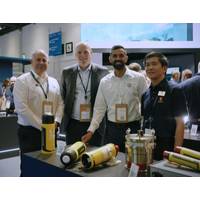
Unique Group Inks $1.7m Deal with Kongsberg Discovery
Unique Group signed a contract with Kongsberg Discovery for $1.7m of advanced seabed mapping and compact acoustic positioning technology for the APAC region.The agreement, for the delivery of cNODE Transponders, µPAP SSBL systems and the recently launched EM2042 multibeam echo sounder (MBES), allows Unique to boost its subsea equipment rental pool.The order, confirmed at Oceanology International in London, will swell the capacity of Unique’s Singapore base, giving customers in South East Asia fresh access to the calibration free µPAP SSBL systems and the lightweight, robust and

Oceanscan Invests in Sonardyne Acoustics
International equipment supplier Oceanscan has added underwater acoustic positioning technology from Sonardyne International Ltd. to its rental fleet. The Mini-Ranger 2 Ultra-Short Baseline (USBL) vessel-based systems and Wideband Sub-Mini 6 (WSM 6) transponders have been acquired by Oceanscan following client demand for accurate and reliable underwater tracking technology to support their projects, especially in the growing offshore wind and shallow water hydrographic survey markets. Compact, portable and quick to install, Mini-Ranger 2 offers a standard operating range of 995 meters, extendable

Dual GyroUSBLs for Allseas' Lorelay Stinger
Offshore pipeline installation and subsea construction company Allseas has ordered Sonardyne International’s GyroUSBL acoustic positioning technology for two systems for its 236 meter long lay vessel Lorelay.Used in conjunction with a Ranger 2 USBL (Ultra-Short BaseLine) topside which also formed part of the order, the GyroUSBL transceivers will be installed on the end of the Lorelay’s stinger to acoustically track a remotely operated vehicle (ROV) deployed to ensure a pipe is accurately touching down in the permitted corridor.USBL transceivers are routinely deployed through the hull or

Sonardyne Awarded Contract from Magseis
Sonardyne International Ltd., UK said it has secured a contract from Magseis to supply seabed node acoustic positioning technology to support an expansion in the Norwegian seismic services company’s deep water survey activities. The equipment ordered includes a large quantity of Sonardyne’s newly developed SST 6 (Small Seismic Transponder 6), and associated vessel-based acoustic positioning system, Ranger 2 USBL (Ultra-Short BaseLine). The hardware will be installed and operated by Magseis’ latest crew which is scheduled to be fully operational during the second

Sonardyne Ranger 2 for RRS Sir David Attenborough
Sonardyne acoustic positioning technology selected for Royal Research Ship Sir David Attenborough Ocean science technology company Sonardyne International Ltd said it has been awarded the contract to supply subsea acoustic tracking and position reference equipment for Britain’s new polar research vessel, RRS Sir David Attenborough. The Ranger 2 Ultra-Short BaseLine (USBL) system will be used by scientists to precisely track the position of, and communicate with, scientific instruments and robotic vehicles deployed from the vessel, including the now famous Boaty McBoatface AUV.

Water Linked Launches Underwater GPS System
Norwegian technology supplier Water Linked has launched a new Underwater GPS system that leverages traditional GPS along with Water Linked’s unique underwater acoustic positioning technology. Designed to enable underwater positioning in a wide new range of marine technology applications, this system is priced at $4,800, half the cost of existing underwater positioning systems. The Underwater GPS Developer Kit is available for order with the first deliveries expected in June 2017. California-based Blue Robotics is the first partner to integrate the Water Linked Underwater GPS

Fugro Selects Sonardyne Acoustics for ROV Support Vessel
One of Brazil’s most advanced ROV support vessels (RSV), the Fugro Aquarius, has specified acoustic positioning technology supplied by Sonardyne Brasil Ltda., to support its subsea inspection, repair and maintenance activities in the region. Already delivered and fully commissioned, the Ranger 2 Ultra-Short BaseLine (USBL) system is being used to track the precise position of the vessel’s Work-class ROVs in water depths of upto 3,000 meters. It is also providing the vessel’s dynamic positioning (DP) system with position reference data to allow it to remain on-location whilst

University of New South Wales Invest In Sonardyne Scout
irregular and can lead to a ‘hidden’ layer of diversity in the ecosystem. Quantifying these impacts and uncovering this diversity calls for precise, geo-located sampling data – a requirement that is now being met following UNSW’s acquisition of the Scout-Pro acoustic positioning technology. At the start of a survey, each member of the dive team is equipped with a small tracking beacon, the exact position of which is continuously monitored by an acoustic transceiver deployed from the side of a surface vessel. The university’s vessel fleet is made up of small

WHOI Selects Ranger 2 USBL for RV Neil Armstrong
Coast of the country. With an endurance of 40 days at sea and accommodation for 20 crew and 24 scientists, Neil Armstrong is equipped to carry out advanced mapping, sampling and sustained observation missions around the world. Sonardyne’s Ranger 2 USBL (Ultra-Short BaseLine) acoustic positioning technology will support the vessel’s work by enabling science teams to precisely monitor the position of underwater targets deployed from the Neil Armstrong. These will include ROVs, AUVs, towfish and seafloor landers. WHOI has been a long-term user of Sonardyne’s Ranger USBL


 August 2025
August 2025





